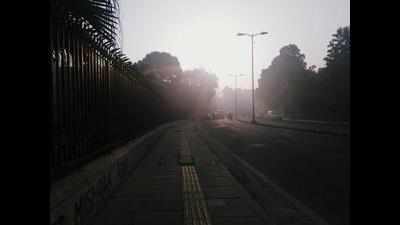- News
- City News
- delhi News
- Delhi’s Vasant Kunj residents champion their air cause
Trending
This story is from October 27, 2016
Delhi’s Vasant Kunj residents champion their air cause
Before stepping out for a jog in the morning, residents in south Delhi’s Vasant Kunj take out their mobile phones and go to the group called Vasant Kunj Air Champions on Whatsapp

(Representative image)
NEW DELHI: Before stepping out for a jog in the morning, residents in south Delhi’s Vasant Kunj take out their mobile phones and go to the group called Vasant Kunj Air Champions on Whatsapp. They look at the air quality reading posted there and then decide whether it is good enough for them to go out. At other times, people scan the group messages to find out if they should opt for a face mask while leaving the house.
“Our user-friendly tool also shows air quality as falling in three zones: red, orange and green.Readings in the red zone mean people need to take caution, that exercising may be harmful for them and masks could be considered,” says Nitish Dogra, who works in the field of climate change and human health.
The air quality readings have changed the way residents look at life. “People adjust their exercise or walk timings if the air quality is very poor on a particular day,” says Chandra Gupta.
All thanks to the effort of Dogra, who wanted to do more than just academically pursue climate and health and carry out an actual study on the air quality in his locality of Vasant Kunj. However, he found the cost of this prohibitive and manpower requirements daunting.
Hearing of his vision, residents of Vasant Kunj Sector A (Pockets B and C) pitched in to purchase an air quality device costing Rs 20,000. The machine has now been functioning for close to eight months. Dogra’s colleague Ashima Munjal suggested using a platform to share the air data with other people, and thus was born the Whatsapp group.
Dogra aims to spread the idea to more RWAs, along with the United Residents Joint Action (URJA), calculating that the Rs 50-100 it could cost residents to collectively buy an air monitoring machine would be a small price to pay for better health.
“Our user-friendly tool also shows air quality as falling in three zones: red, orange and green.Readings in the red zone mean people need to take caution, that exercising may be harmful for them and masks could be considered,” says Nitish Dogra, who works in the field of climate change and human health.
The air quality readings have changed the way residents look at life. “People adjust their exercise or walk timings if the air quality is very poor on a particular day,” says Chandra Gupta.
All thanks to the effort of Dogra, who wanted to do more than just academically pursue climate and health and carry out an actual study on the air quality in his locality of Vasant Kunj. However, he found the cost of this prohibitive and manpower requirements daunting.
His thoughts then shifted to an air quality monitoring system that would show the PM2.5 (fine, respirable polluting particles) and PM10 (coarser pollutants) levels in the area in real time. “The idea was to raise awareness among people so they could take steps for their protection,” explains Dogra, a public health specialist who trained at a Johns Hopkins institution. “The problem with this is that most air monitoring systems are located far from where a person might be living, making it difficult to find out how bad the air is around him or her.”
Hearing of his vision, residents of Vasant Kunj Sector A (Pockets B and C) pitched in to purchase an air quality device costing Rs 20,000. The machine has now been functioning for close to eight months. Dogra’s colleague Ashima Munjal suggested using a platform to share the air data with other people, and thus was born the Whatsapp group.
Dogra aims to spread the idea to more RWAs, along with the United Residents Joint Action (URJA), calculating that the Rs 50-100 it could cost residents to collectively buy an air monitoring machine would be a small price to pay for better health.
End of Article
FOLLOW US ON SOCIAL MEDIA










